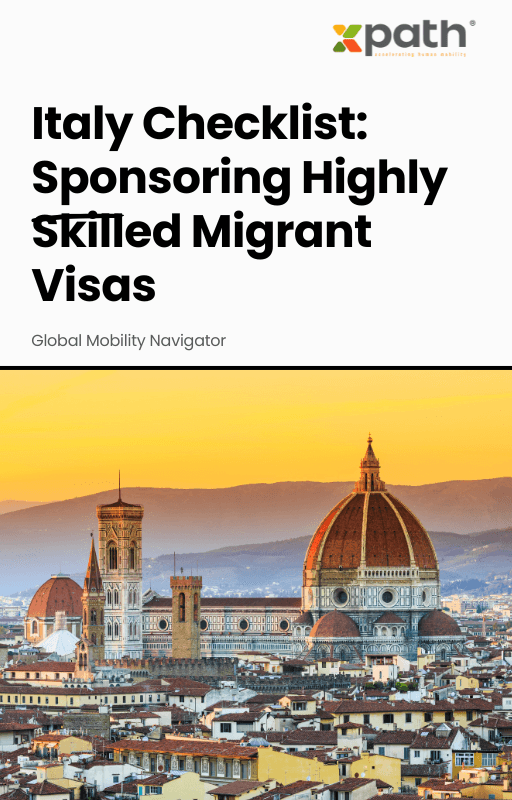Italy Checklist: Sponsoring Highly Skilled Migrant Visas
Grab a copy of a guide to international employee relocation
View E-bookWhen it comes to running multinational companies today, the need for smooth and effective global mobility solutions is front and center—especially in complex, high-growth markets like China, India, and Brazil. The possibilities are huge: vast talent pools, expanding consumer bases, and thriving ecosystems. But if you’ve ever tried moving employees into, out of, or across these markets, you’ve likely encountered your fair share of complexity. From legal labyrinths to cultural curves, deploying talent in these regions isn’t for the faint-hearted. But here’s the kicker—it also offers some of the most rewarding business opportunities on the planet.
In the past decade, China, India, and Brazil have transformed from “nice-to-have” expansions to mission-critical components of global strategy. According to the World Economic Forum, China stands as the world’s second-largest economy, India is projected to surpass Japan and Germany by 2030, and Brazil anchors business in Latin America. Their combined workforces top 2.7 billion—an eye-watering figure for talent-hungry organizations.
Yet, for all their potential, these markets are layered with regulatory, logistical, and cultural hurdles. Mobility program managers often find themselves playing chess with constantly shifting rules, complex visa protocols, and fierce local competition—not to mention language barriers and unique business norms.
To put things in perspective, let’s look at some telling statistics:
China issues over a million work and residency permits for foreigners each year, yet local compliance regulations shift frequently. Deloitte’s Global Workforce Trends report found that 55% of companies relocating staff into China in 2023 reported unexpected tax or regulatory complications.
India processed more than 7 million employment-based visas in 2022, but 63% of global mobility leaders polled by Mercer cite India’s relocation landscape as among the “top three most challenging” globally, driven by intricate labor laws and regional nuances.
Brazil, meanwhile, has seen a 25% increase in inbound assignments since 2020. However, the complex processes for CPF (tax ID) registrations, foreign national work approvals, and language requirements often delay onboarding by weeks or even months.
What’s more, PwC’s latest study shows that over 40% of organizations ranked China, India, and Brazil “high risk” for non-compliance during cross-border assignments, underscoring why robust, tech-driven global mobility solutions are quickly becoming non-negotiable.
If you’re managing mobility programs into these regions, you already know it’s not just about booking flights and securing housing. Here’s what typically keeps HR and mobility professionals up at night:
1. Regulatory Labyrinths: Each country has its own constantly evolving visa categories, tax regimes, social security requirements, and reporting obligations. Missing a regulation can lead to costly fines, rejected permits, or even forced repatriations.
2. Local Talent Laws: Both India and Brazil strongly protect local job markets, often requiring companies to demonstrate that no local talent is available before securing foreign worker permits. China’s point-based system for skilled expats keeps everyone guessing, as priorities shift with new five-year plans.
3. Cultural Considerations: From Chinese “guanxi” (relationship networks), to India’s diverse linguistic and cultural regions, to Brazil’s need for localized social security and employment contracts, one-size-fits-all simply doesn’t work.
4. Cost Predictability: Budgeting is tricky. Currency volatility, local taxes, and unplanned compliance costs can throw forecasts off course, and these countries aren’t exactly famous for fast government processing times.
Let’s take a look at how one multinational tech giant modernized its mobility program for fast-track expansion in India and Brazil. The company faced bottlenecks from scattered service providers, inconsistent immigration advice, and manual tracking prone to human error. By plugging into a single platform—like xpath.global—they centralized their vendor network, streamlined documentation, and gained real-time visibility on every assignment.
Within 12 months, the company slashed average onboarding times by 30%, reduced budget overruns by 22%, and improved assignee satisfaction according to post-assignment surveys. The underlying secret? End-to-end integration for everything from compliance checks to vendor payments, all tailored for local market demands.
So, what separates a clunky, reactive mobility program from a competitive powerhouse? In short: digitization. Solutions like xpath.global harness automation, global compliance tracking, multilingual workflows, and instant reporting. This means fewer manual touchpoints, greater oversight, and less room for (expensive) error.
Imagine this: Instead of juggling 10 spreadsheets and five local vendors, your team uses one dashboard. Approval chains, regulatory alerts, and document submissions are centralized and auditable. And because everything’s driven by up-to-date local intelligence, you can react immediately to policy changes without scrambling. This is how organizations break free from chaos and build scalable, adaptable mobility programs for China, India, and Brazil.
Without question, China, India, and Brazil offer unmatched potential for growth—but only for those committed to mastering their unique challenges. Getting your mobility solution right isn’t just a tick-box exercise; it’s the backbone of your international talent strategy. The good news? Modern, global-mobility platforms exist to make the process more transparent, compliant, and—dare we say—less stressful.
If your business is eyeing these regions for expansion, now’s the time to re-evaluate your approach. Partner with experts, leverage tech-powered solutions like xpath.global, and transform complexity into competitive advantage. Because in today’s hyperconnected business world, your success truly hinges on moving talent swiftly and seamlessly across global hotspots.
Ready to transform your mobility program? Explore xpath.global’s solutions.

Italy Checklist: Sponsoring Highly Skilled Migrant Visas
Grab a copy of a guide to international employee relocation
View E-book